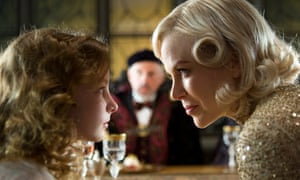 |
| Lyra (Dakota Blue Richards) on a Panserbjørn in the 2007 film of Northern Lights, The Golden Compass. Photograph: Sportsphoto Ltd./Allstar |
His Dark Materials: the enduring, terrifying appeal of Philip Pullman's world
La Belle Sauvage will return readers to Lyra’s universe tomorrow, 17 years after Pullman’s original trilogy ended. But His Dark Materials remains a radical read – and a true modern classic
Kiran Millwood Hargrave
Wed 18 Oct ‘17 14.06 BST
Children’s authors are always being invited to speak in schools and, at every visit, I ask the question: “If your soul was in animal form, what would it be?” Without fail, every hand goes up.
Daemons capture the imagination in a way that few other concepts do. Reading Philip Pullman’s Northern Lights as a 10-year-old, it made perfect sense to me that people should have a crucial part of themselves that inhabited a separate, animal being: two halves of the same whole. Like many children, I longed for my own daemon, but not in the way that I longed for my Hogwarts letter. Daemons were not magical diversions, but a way of bedding deeper into your reality. In place of escape, they offered understanding.
From Lyra and Pantalaimon’s first whispered conversation in the wardrobe in that opening novel in his trilogy, Pullman wastes no time establishing a world: the characters, and therefore the readers, are plunged into the action without explanation or apology. They just are. For me, this is a key part of the His Dark Materials books’ enduring appeal. The way Pullman conjures the worlds needs no qualification, because they are never so alien that we cannot recognise them. They are familiar and strange all at once, the ultimate unheimlich.
Reading Northern Lights opened the world up to me in a way I’d never experienced before, even with my other great childhood love, Harry Potter. When I travelled through Lyra’s Oxford for the first time, I felt that such a place was entirely possible; in some ways, I still do. When Serefina Pekkala’s daemon Kaisa stretches her wings and tells Lyra she has brushed countless other realms, it’s simply “many-worlds” quantum theory (with added geese). This is where the true, quiet magic of these books lies for me. Its worlds are not exclusive, lying behind closed doors: they are simply elsewhere.

Dakota Blue Richards (left) as Lyra in the film version of Northern Lights, The Golden Compass. Photograph: Laurie Sparham/New Line Cinema/Handout
His Dark Materials is radical reading for youngsters in many ways, because it is truthful in many ways: about how the world is, and how children are. The angels Balthamos and Baruch were among my earliest reading about gay love. Pullman also does great service to the women in his books: they are academics, flawed mothers, heroes, sexual beings; in short, allowed to be human.
What adults often forget is that we spend most of our childhoods wanting to grow up. But Pullman understands this in a way that much classic nostalgic literature doesn’t. Childhood innocence is a concept that exists in the minds of adults: in reality, the playground is more brutal than the boardroom. And loss, love and friendship are all at their most terrifying and powerful the first time you experience them. What’s more, Pullman celebrates this loss of innocence: he sees the lifting of the veil, the imbibing of knowledge, the desire to question and expand your views as vital and necessary, and not to be shunned.
Dust, the mysterious matter at the heart of the tale and object of Will and Lyra’s quest, is consciousness, or rather, the transference of consciousness from one atom to another. In His Dark Materials, Pullman seems to say that the worst fate is not death: it is ambivalence. His antagonists are the Magisterium, a dictatorial religious order who seek to stamp out challenge and enquiry: angels are administrators. Pullman’s book doesn’t read as anti-God to me so much as against the cruelty, censorship and bureaucracy that accompanies organised religion.
His Dark Materials is many things to many people: it changes its guise as quickly as a child’s daemon, moving smoothly from fantasy quest to political thriller, murder mystery to love story. On my first read, it was all adventure, a swirl of witches and armoured bears and knives that could cut through the very fabric of air. But as I’ve reread the series nearly 10 times over nearly two more decades, it’s become about growing up in all its terrifying, world-destroying power.
Which is why I am elated by the publication – on Thursday – of The Book of Dust. We will not only see our beloved Lyra as a baby, but also as an adult. We never stop growing, and it is Pullman’s dearest wish for us that we never stop learning, either. His Dark Materials is still teaching me 17 years on. As Pullman has it: “‘Thou shalt not’ might reach the head, but it takes ‘Once upon a time’ to reach the heart.”
• Kiran Millwood Hargrave’s books include The Girl of Ink and Stars.


No comments:
Post a Comment